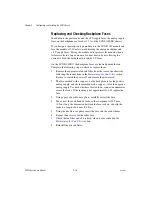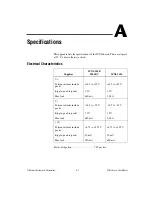
Chapter 2
Configuring and Installing the SCXI Chassis
©
National Instruments Corporation
2-15
2.
The fuse marked with a on the backplane is for the positive
analog supply, and the fuse marked with a copper – is for the negative
analog supply. To check whether a fuse is blown, connect an ohmmeter
across the leads. If the reading is not approximately 0
Ω
, replace
the fuse.
3.
Using a pair of needle-nose pliers, carefully extract the fuse.
4.
Take a new fuse and bend its leads so the component is 12.7 mm
(0.5 in.) long, the dimension between the fuse sockets, and clip the
leads to a length of 6.4 mm (0.25 in.).
5.
Using the needle-nose pliers, insert the fuse into the socket holes.
6.
Repeat for the other fuse if necessary.
7.
Check the fan filter and, if it is dirty, clean it as described in the
section.
8.
Reinstall the fan and filter.
Replacing the Fuses on the SCXI-1000DC
There are two fuses located on the rear panel of the SCXI-1000DC. The
input power fuse (F1) is a 6.3 A, 5
×
20 mm time-lag fuse. The internal
+5 VDC supply is fused by a 3.15 A, 5
×
20 mm time-lag fuse (F2).
Replacing the Power Entry Fuse and +5 VDC Fuse
Caution
For continued protection against fire, replace fuses only with fuses of the same
type and rating.
Complete the following steps to replace the rear panel fuses:
1.
Power off the chassis.
2.
Remove the power cord from power entry connector J1.
3.
Turn the fuse holder counter-clockwise with a screwdriver and pull out
the fuse holder to expose the fuse in the housing.
4.
Remove the fuse.
5.
Install the new fuse.
6.
Push the fuse holder back into the housing and screw it clockwise until
it is secure.
7.
Reinsert the power cord.
















































